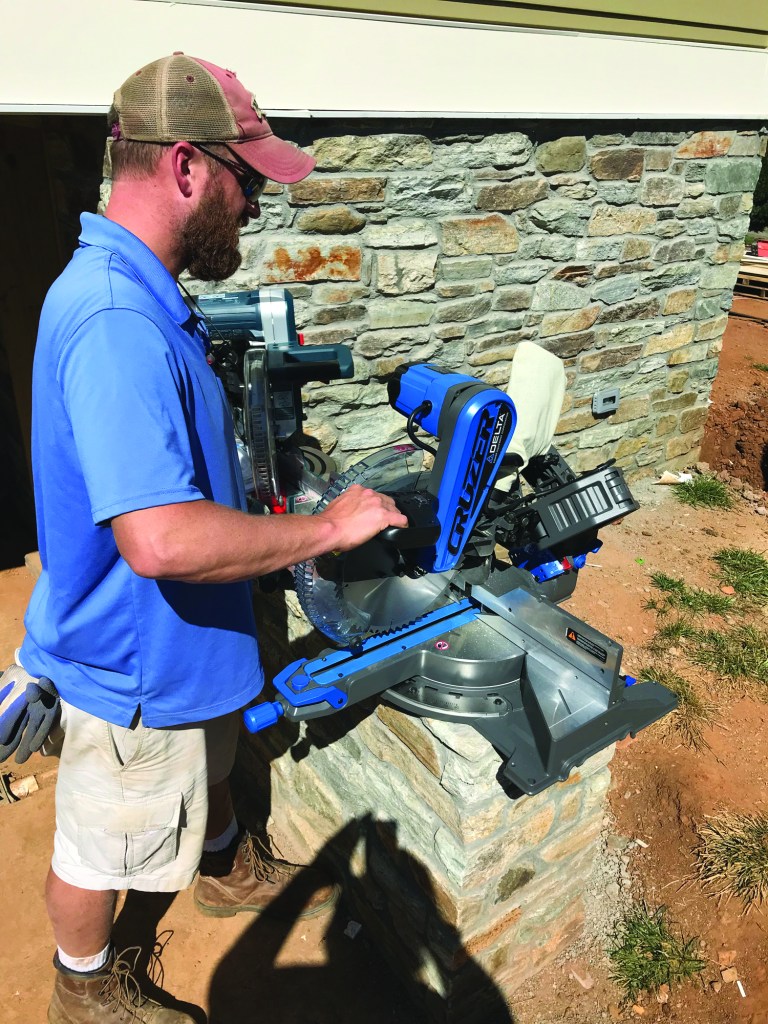Last fall, the team at BOWA Builders received a sampling of brand-new 12-inch sliding compound miter saws. After unpacking them, one of our lead carpenters and I spent a couple of weeks testing them against pressure-treated pine framing material, standard and engineered lumber framing material, 1-by trim material, large and small crown molding, and small picture-frame and cove detail molding materials. We wanted to get an understanding of how the saws performed in a variety of work environments.
We found that all the saws performed well in different applications, with the top two or three extremely close in rating. In fact, we liked them all and felt that professionals in the field would be happy with the performance of any of them. Here’s a summary of what we discovered in our testing.
Delta 26-2250 Cruzer
Out of the box: Out of all the saws, the Delta (see photo, right) was the one that we had heard the most buzz about from industry friends and peers. It’s an impressive-looking tool with its retractable sliding arms (like something out of a Transformers movie), and it made perfect miter and bevel cuts right out of the box.
Power: The Delta’s belt-driven 15-amp motor cranked through all the wood we could throw at it. When switching the saw on, we could feel the power of the belt drive. This saw seemed to offer the best combination of power and accuracy for those who need a saw for both framing and trim work.
Accuracy: The laser guide worked perfectly and was accurate on all cuts. The bevel cuts were effortless to set up, as all the bevel controls are in the front of the saw. The sliding arms worked great, but we found that we had to be careful not to pull on the handle grip to the right or to the left when cutting, as there seemed to be a small amount of play when even pressure wasn’t applied to the saw arm.
Mobility: The space-age sliding arms are great for cramped jobsites and tight shop environments. You can back the saw right up to a wall, and it still operates correctly. At 60 pounds, it would be manageable for someone who frequently moves a saw around.
Features: Delta boasts that this saw has patented military-grade aluminum sliding arms. The saw has 50-degree-left/60-degree-right miter cutting capacity and an impressive 18-inch crosscutting capacity, thanks to an adjustable flip-down fence design. It also features one-hand front miter controls, a flip-down side lock for accurate plunge cuts, and a five-year warranty. While the performance of the dust collection bag system was only average, we particularly liked the adjustable sliding tension, which allowed us to personalize the saw for our cutting styles.
Cons: The throat plate is very open and wide. That allowed a lot of small pieces to fall into the saw when I was cutting detailed trim pieces, so I had to keep cleaning out the saw trim debris.
Price: The Delta lists for $650, which is at the high end of the saws we tested. It is probably best suited for professionals who need a single saw that will stand up to everyday use while staying accurate.
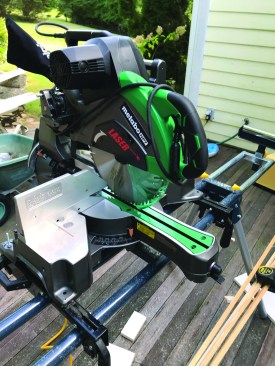
The least expensive saw in the group, Metabo HPT’s C12RSH2 has a compact footprint and offers good dust collection.
Metabo HPT C12RSH2
Out of the box: When I removed the Metabo HPT (see photo, next page) from its box, I noticed that the miter slide handle had broken during shipping, but I was able to super-glue it back together for the testing. The first cut was accurate, but the bevel cut was a little off and needed to be adjusted.
Power: This saw seemed to have average power. It had no problems cutting through any of our trim materials but struggled a bit through the larger (4×4 and 4×6) deck framing materials.
Accuracy: As mentioned, the bevel cut had to be adjusted; however, the adjustable laser light worked well and was a nice feature. The cuts aligned perfectly with the laser line on all materials.
Mobility: Weighing in at 59 pounds, this saw wouldn’t be difficult to move from one jobsite to another. Its compact sliding system allows it to be backed up to a wall or structure while in use—which is good for working in tight spaces or close quarters.
Features: The Metabo HPT has a 15-amp motor, large sliding fences for cutting substantial trim materials, 0–45-degree-left and 0–57-degree-right miter cut capability, quick stops for miter and bevel cuts, a five-year warranty, and—most important to this reviewer—a light weight.
Cons: The electric brake was slow to respond, and there seemed to be some blade wobble after a day of testing. The miter sweep was not super smooth and slowed us down a bit when we were cutting tediously detailed trim pieces.
Price: We found the Metabo HPT listed for $413, which makes it the least expensive of the bunch.
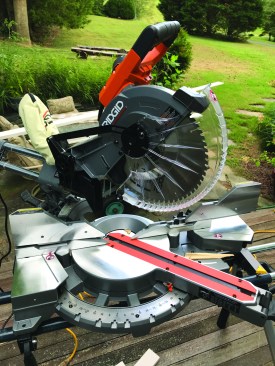
Ridgid’s value-priced R4221 is capable of cutting 67-degree miters both to the right and to the left—best in class.
Ridgid R4221
Out of the box: Weighing 64 pounds, the Ridgid (see photo, facing page) is massive; it took us 15 to 20 minutes to unpack it and put the pieces together. After the first few cuts, we noticed a slight blade wobble that required adjustment to fix the problem. The slide was also not particularly smooth, something we were not able to fix.
Power: The Ridgid’s 15-amp motor didn’t have any problems cutting any of the materials we ran the saw through.
Accuracy: The blade light on this saw worked well and was accurate on all cuts once we corrected the blade wobble. All the bevel and miter cuts seemed to be true as well.
Mobility: Because this saw is huge, I wouldn’t recommend it to someone who is setting up and breaking down every day. It’s more suitable for a shop-type setup.
Features: The Ridgid has an LED cut indicator, 15-amp motor, dust collector vacuum adapter, 0–67-degree miter capability left and right, a lifetime service agreement, and a three-year limited warranty. Dust collection using the dust bag is average.
Cons: The blade wobble out of the box was annoying, as I expect a new saw not to have that problem. The slide not being smooth was also a disappointment. The Ridgid’s overwhelming size is too large for me but is probably suitable for a DIY-er or a home-shop woodworker.
Price: We found the Ridgid listed for $500, which grouped it in the less expensive category of similar saws.
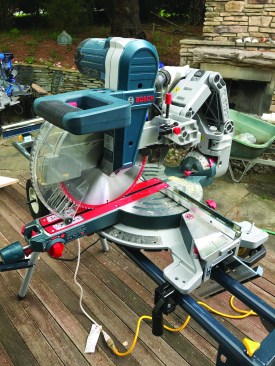
Accurate right out of the box, Bosch’s GCM12SD has a beefy, well-designed fence system and efficient dust collection.
Bosch GCM12SD
Out of the box: I have used previous versions of Bosch’s 12-inch SCMS, which has earned a reputation as “the professionals’ saw” in the trades. Out of the box, I was struck by the many new adjustment features, which felt almost overwhelming, on the latest version of this saw (see photo, next page). Our first test cuts proved the Bosch very accurate. We also noticed the fencing detail was much more robust than on previous versions, with measurement and benchmarks right on the fences themselves. We also liked the retractable extended base support that comes with this saw. It came in handy.
Power: The Bosch is cranked by a 15-amp motor, with power that was repeatable through most cuts. However, we had trouble when cutting bevels on 2-by framing material. The saw seemed to be bogging down before powering through the lumber. Thinking it was a fluke, we tried several more times, but got the same result. We also tried changing the blade, to no avail.
Accuracy: As we expected, this saw was very accurate. The new fencing details were a bonus that made accuracy of squaring easy when we were making precision cuts, such as when cutting crown molding.
Mobility: The saw’s axial glide system makes it easy to use in tight spaces, even though it is a big saw. Weighing in at 65 pounds, it can be a leg banger when you move it. It would be perfect for a large trim-job setup, where the saw is staying put for a week or two.
Features: The Bosch features a pre-aligned square lock fence system, integrated expanding base extensions, 52-degree-left/60-degree-right miter capacity, 47-degree-right and -left bevel angle with marked rafter detents (we love this feature), and an ergonomic trigger. The bag dust collection was superior with this unit, and as on most of the other saws, it can be hooked up to a vacuum system for even better performance. It comes with a one-year warranty.
Cons: We did not like the three-step-plus operation to cut right-side bevels. We found ourselves flipping over boards and cutting with the left-side bevel to save time. The lack of power cutting through 2×10 material on a bevel was also a bit of a disappointment.
Price: The Bosch lists for about $600, which places it in our higher-priced saw bucket. I would recommend it for professional carpenters or woodworkers rather than the average garage-shop DIY-er.

Skilsaw’s powerful SPT88 wormdrive dual-bevel 12-inch SCMS has a big footprint, yet weighs in at only 51 pounds.
Skilsaw SPT88
Out of the box: The first saw my father bought for me when I was a kid was a Skilsaw circular saw, which I used to build tree forts, planters, and my first projects in high school, so I was rooting for this saw (see photo, above right). My first impression out of the box was that it was big but extremely light and easy to pick up. We tested the fence accuracy to 9 degrees and found quite a bit of play. The fences also seemed to be loose, regardless of where we adjusted them or how tightly we tried to lock them down.
Power: This wormdrive Skilsaw sounds like a top fuel dragster starting up when engaging the blade. It is powerful and had no problem cutting through all the test material. The saw literally almost jumped off the saw stand. You can feel the power of this saw; there is no doubting it.
Accuracy: The miter and bevel cuts were accurate, and the lock for the bevel, even though it was in the back of the saw, was easy to use. The shadow line worked great and accurately. We found we had to pay close attention to the fence movement when cutting detailed crown molding. Because of the play in the fence system, I feel more comfortable recommending the Skilsaw for framing use than for detailed trim projects.
Mobility: This is a big saw, but it’s easy to move due to its light, 51-pound weight. I think it could be moved from job to job without too much of a problem.
Features: The Skilsaw has a 15-amp dual-field motor with the company’s famous wormdrive power, crown stops, sliding base extensions, 4×14-inch crosscut capacity, 50-degree-left/60-degree-right miter cutting capacity, and 45-degree bevel cutting capacity. The dust bag provided average dust collection. It comes with a one-year limited warranty.
Cons: The base extensions moved a bit and did not sit level with the table. The fencing was the biggest disappointment, as we had to keep checking when cutting trim that we had a true 90 degrees set.
Price: The Skilsaw lists for $650—close to the top of all the tested saw prices.
Cordless options
In our field-testing, we also tried out a hybrid saw—the DeWalt DHS790—which can be plugged into an outlet or run off a pair of FlexVolt batteries—and a cordless saw, the Makita XSL08. Both proved capable of competing with their corded cousins; in fact, we consider the DeWalt to be the best saw of the seven that we tested, with the Makita close behind. We liked having the cordless and corded options on the DeWalt, and its manageable weight made it easy to set up and tear down. We consistently got repeatable, accurate cuts (after making a slight bevel adjustment) and found ourselves reaching for the DeWalt more than the others once we were on the jobsite. We also liked the accuracy and options on the Makita, but the saw’s overall size was too large for us to move it into the top-dog status.
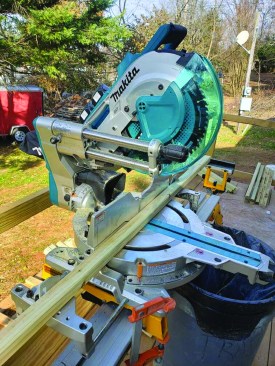
Makita XSL08
Out of the box: Right out of the box, I noticed that the Makita was a monster. In fact, it took me close to 30 minutes to remove the saw from the box, organize the parts and pieces, and attach the blade. Because of the cordless option, I was expecting a more compact, lighter saw. It is not. It was tough to carry and set up. Once I set it up, however, all the fencing and other pieces were tight and true.
Power: The Makita seemed to have excellent power, and the two 18-volt lithium-ion batteries lasted for more than a day of heavy use. It performed well with both framing lumber and trim pieces.
Accuracy: The miter and bevel cuts were incredibly accurate. The trim cuts were the cleanest we had seen, and this beast handled all the 2-by framing lumber we ran through it just as accurately. The laser light worked perfectly.
Mobility: Did I mention that this saw is huge? It weighs 69.1 pounds with batteries, and moving it from the truck to setup is a workout. It does boast a single-slide operating system that allows it to back up against a wall or structure in use.
Features: The Makita includes almost too many features to list here, including a Makita build brushless motor, an Auto-Start Wireless System (AWS) that uses Bluetooth technology to operate your dust collector, a front-lock bevel adjustment system, and dual dust-port locations. We found that dust collection with the bag that comes with the saw was above average.
Cons: The heavy weight of this unit even though it’s cordless is something we have a hard time understanding. The saw is also a bit expensive, but as the saying goes, “you get what you pay for.”
Price: The Makita lists for about $600. Be careful to check if the batteries are included or not; we found it both ways at different suppliers and home stores.
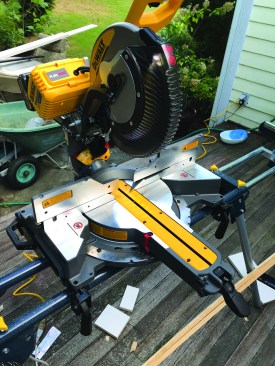
DeWalt DHS790
Out of the box: Like the Makita, this saw seemed like it had many parts when we first opened the box. Again, that was due to the cordless features, which included a dual charger, batteries, and a corded power supply unit.
Power: The DeWalt powered through everything we had “like butter.” There was no difference in power between using the supplied batteries (as long as they were charged) and using the corded power supply. When the batteries run low, the saw light blinks, a helpful feature.
Accuracy: We loved the LED shadow light system. It was super accurate except in direct sunlight. The extra-tall saw fences were “right on” square. All miter cuts were very accurate, but we had to adjust the bevel because the bevel cuts were a few degrees off when we first tried a bevel cut.
Mobility: The saw is compact, and we used it on multiple jobs throughout the week. It weighs in at 56 pounds, so it is manageable to lug around.
Features: The DeWalt comes with two 20V/60V Max batteries, a dual battery charger, a DCA120 corded power supply adapter, an extra 12-inch blade, and a dust bag. The saw has a three-year limited warranty. We were able to work all day with the batteries on one charging cycle (approximately 200 cuts). We tried the backfin fence stops to cut 16-inch material, and they worked well. Dust collection was above average using the dust bag.
Cons: The only drawback we could find (besides the price) was the bevel cut being out a degree or two, but this was easily fixed with a quick adjustment.
Price: This saw lists for about $800, the priciest in the group.
Conclusions
All the saws performed well in our testing, and the top four—the corded models from Delta and Bosch and the cordless models from DeWalt and Makita were all extremely close in rating. We liked the power of the Skilsaw but feel the manufacturer needs to refine the components a bit more to make it a great saw. The offerings from Ridgid and Metabo are at great price points and are good options for someone willing to accept slightly less performance in exchange for a lower price.
Photos by Tim Burch
